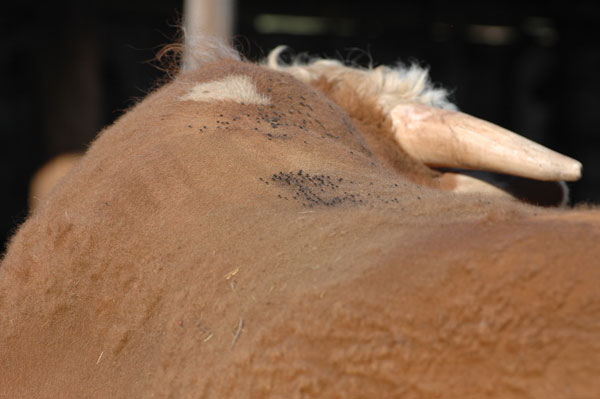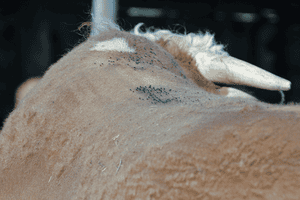The bug battle is coming; how to be prepared for cattle flies this summer
It’s time to gird yourself for the annual battle of the bugs. See our 2016 Parasite & Pest Management Product Listing here.
April 7, 2016

Springtime’s a-coming, and that means the flies aren’t far behind. The battle against flies is constant during warm weather, but there are several ways to reduce these pests. Different flies have different habits and behavior, so a combination of tactics is most effective. Here’s a look at how you can gird yourself for the annual battle of the bugs.
Stable flies
Typically, stable flies are more of a problem where cattle are confined and fed. “The stable fly situation has changed significantly, however, in the past 50 years,” says Bill Clymer, a Ph.D. livestock parasitologist and rancher near Amarillo, Texas. “When I was growing up, we only saw stable flies around barns and pens. Today, they have become a pasture problem as well. I attribute this to the use of large bales fed out on pasture in feeders,” he says.
“I assisted with a research project in which we found more than a million stable flies in the debris from each round bale site that didn’t get cleaned up off the pasture in the spring. This residual debris from wasted feed can create ideal breeding ground for stable flies,” says Clymer.

“When I was growing up, we only saw stable flies around barns and pens. Today, they have become a pasture problem as well.†Bill Clymer
“Here on our ranch, when we are done feeding round bales in the corrals or small pastures, we clean out those areas, along with the ground where hay and straw — mixed with manure — have been trampled down into the soil. If we can clean those up before fly season starts, and spread out the piles so they can dry out, or pile them in a correctly built compost area, they won’t be propagating flies. If you put black plastic over the top of those big piles, you can bake the maggots,” he says.
“We normally have two stable fly seasons each year, spring and fall, when there’s moisture. In midsummer, especially in Southern regions, it can get too hot for stable flies. When it gets 95 to 100 degrees [F] and things start drying up, stable fly populations crash pretty fast. But the main key is sanitation.”
About 95% of the stable flies develop in less than 5% of the area where the cattle are. “If you can clean up those areas, you might not need to clean the whole pen. There will often be thousands of maggots in an area about the size of a desk. You might pull samples from all over the pen and only find one maggot in every 10 samples, until you hit that mother lode of fly larvae. If you clean those up, drain the wet spots, etc., you won’t have very many flies,” says Clymer.
Other tactics include use of beneficial insects like tiny parasitic wasps that lay their eggs in fly pupae. “These can work if purchased from a reputable company, but they are just one tool. They won’t solve a problem if you neglect sanitation,” he says.
Producers need to know how to target stable flies. “We’ve had clients who rode across their pasture, sprinkling parasitic wasps out where their cattle were. I had to tell them that parasitic wasps work best in a more confined area, such as a feedyard where there’s spilled feed and moisture where the flies breed,” Clymer says.
Roger Moon, professor of entomology at the University of Minnesota, agrees that sanitation is key in controlling stable flies. “If [leftover hay and manure] is deeper than an inch and/or there’s enough moisture, these accumulations may be breeding areas clear into August,” says Moon.
“If you use round hay bale feeders or unroll big bales, keep moving the feeding area, so any wasted hay does not accumulate. Old feed gets contaminated with manure, and if it gets enough depth, there’s a wet area — even in dry years — that stays moist and attracts flies. We are not sure where the original adults come from in the spring, but in our region they may be coming from semiheated barns. These flies can’t handle freezing,” he says.
“If you keep those piles from developing in the first place, you reduce the urgency to clean up debris in the spring. If it’s not practical to change feeding areas regularly, your next best plan is to dispose of the debris. It can be disked or hauled and spread on pasture or crop ground. Spreading thinly prevents fly breeding — but if you just scoop it up and dump it somewhere, you’ve just moved the problem somewhere else,” Moon says.
Flies are costly. “Dave Taylor [a USDA Agricultural Research Service researcher in Lincoln, Neb.] and I wrote a review of stable fly knowledge, and estimated that for all kinds of cattle enterprises combined — stockers, feeders, cow-calf, etc. — stable flies are costing the industry more than $2 million per year, and that does not include costs of control,” says Moon.
Horn flies
“In terms of misery to the animal, horn flies in large numbers may be worse than stable flies. In large operations out West where cattle are spread over huge range pastures, stable flies are not as big a problem as horn flies. The cattle are far away from winter feeding pastures where stable flies breed. In hot, dry summer, horn flies will keep going, whereas stable flies will slow down. In many beef operations, horn flies are the most irritating and costly parasite,” Moon says.
Doug Colwell, livestock parasitologist with Agriculture and Agri-Food Canada, Lethbridge, Alberta, says some producers are trying to use fewer chemicals and pesticides, but for horn fly control, the non-chemical options are limited.
“There are some fly traps that can help; in one method the cattle walk through the chute/trap, flies are rubbed off their backs and fly up into a structure which drives them up and away from the cattle and into a catching device. They can’t get out and [they] die there. This kind of trap works best where cattle have to walk through it to go to water, or set up in a pasture after cattle become accustomed to using it, and find they get relief from flies by walking through it. Some cattle are too suspicious to go through it, however,” he says.
Traps are only partially effective. This is why many ranchers love insecticide ear tags that can be installed before cattle go to summer pasture. Now, however, some flies have become resistant to the chemicals in these tags. Most producers leave tags in too long, and as their potency drops in late summer, they only kill the most susceptible flies, leaving resistant ones to reproduce.

How many flies are too many? It’s time to consider fly control when flies number 100 per side or 200 per animal.
Insecticide ear tags mainly contain pyrethroids and organophosphates, but two more categories just came on the market, Moon says. “We generally don’t think of ivermectin as a topical insecticide for horn fly control, but it’s on the label of one. There’s also a new class of insecticide, a compound called tolfenprol, registered for horn fly control.”
Says Moon, “We’ve switched among the different kinds of pyrethroid insecticides, and cross resistance is probable, which means we’re really not rotating unless we change to organophosphate tags. Now, however, we can have a three-way rotation, and if you count the ivermectin we have a possible four-way. If a producer has lost efficacy to pyrethroids, a switch can be made to organophosphates and then to tolfenprol.”
Other tactics include feed-through products and the old methods of dust bags, back rubs and oilers to apply insecticide at certain times during summer when fly populations are high. “We recommend not using any insecticide until there are a certain number of flies; wait until early July when populations are higher,” says Colwell. “Then you can knock them back with insecticide.”
The question then becomes, how many flies are too many? “The point at which some folks feel you need to be concerned is 100 flies per side, or 200 per animal,” Moon says. “You can live with a few, and refrain from treating them until the population builds up, and then hit them with a control tactic so you can knock them down for a while, and slow down selection for resistance.”
According to Moon, “It’s not that horn flies are bothering the calves so much as they bother the cows, and milk output is dropping. If producers can knock down horn flies for maybe a six-week period, they can get their money back, but aiming for full-season control may be too costly. The horn flies don’t become really abundant until July or August, depending on how far north or south you are,” Moon says.
“There is no easy answer,” says Colwell. “Flies are an irritant, and ranchers may try to do something about it, or choose to do nothing because they can’t see the losses — the 14% or more that it costs you to raise cattle with that many horn flies.”
You might also like:
Get to know the 2016 Seedstock 100 operations
5 tips to make bull buying easier
Cow prolapsing? Here's what to do
March cattle markets In like a lamb and out like a lion
Why the USDA suspension of the midyear Cattle report is troubling
Here's how attaining zero calf sickness is absolutely possible
You May Also Like


.png?width=300&auto=webp&quality=80&disable=upscale)
